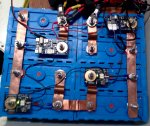Poey50
Well-Known Member
That's why a hybrid system appeals to me. Something like a gel battery in parallel with the LFP. BMS shuts down the FLP battery and the gel takes the load. Sure the kettle, hair dryer and windlass won't work. However, if you are at sea, then VHF chart plotter and AP should continue for sometime. If the engine or solar also continues to charge what's left of the house bank, it may not be a complete snafu.
If you are going to follow the Zwerfcat method Lithium-Hybrid although it looks straightforward it is worth noting that they are not using drop-in batteries but instead an external BMS of their own design. The method relies on the LFP being taken offline by the BMS when it is sufficiently charged and sufficiently discharged. It is a homeostatic system moving between lead acid and LFP making use of their different charging characteristics and theoretically works without a lot of user input. However the BMSs of drop-in systems have parameters not usually designed for this kind of use since they are generally set at higher and lower cell voltages. They will protect the battery from very serious damage but using them routinely in a Zwerfcat system would serious shorten their lives. Since drop-ins are the most expensive way of buying LFP then this would be a very costly method over time. Drop-ins don't have user-adjustment in the way that an external BMS has. You could certainly use a 123SmartBMS in a Zwerfcat system.
Last edited:


